Accounting and Finance for Decision Making: Unilever Investment Report
VerifiedAdded on 2023/06/10
|10
|2198
|500
Report
AI Summary
This report provides a comprehensive analysis of Unilever's investment potential, focusing on the impact of COVID-19 on the company's financial performance. It examines the motivation behind proposed investments, emphasizing long-term growth and expansion strategies. The report incl...
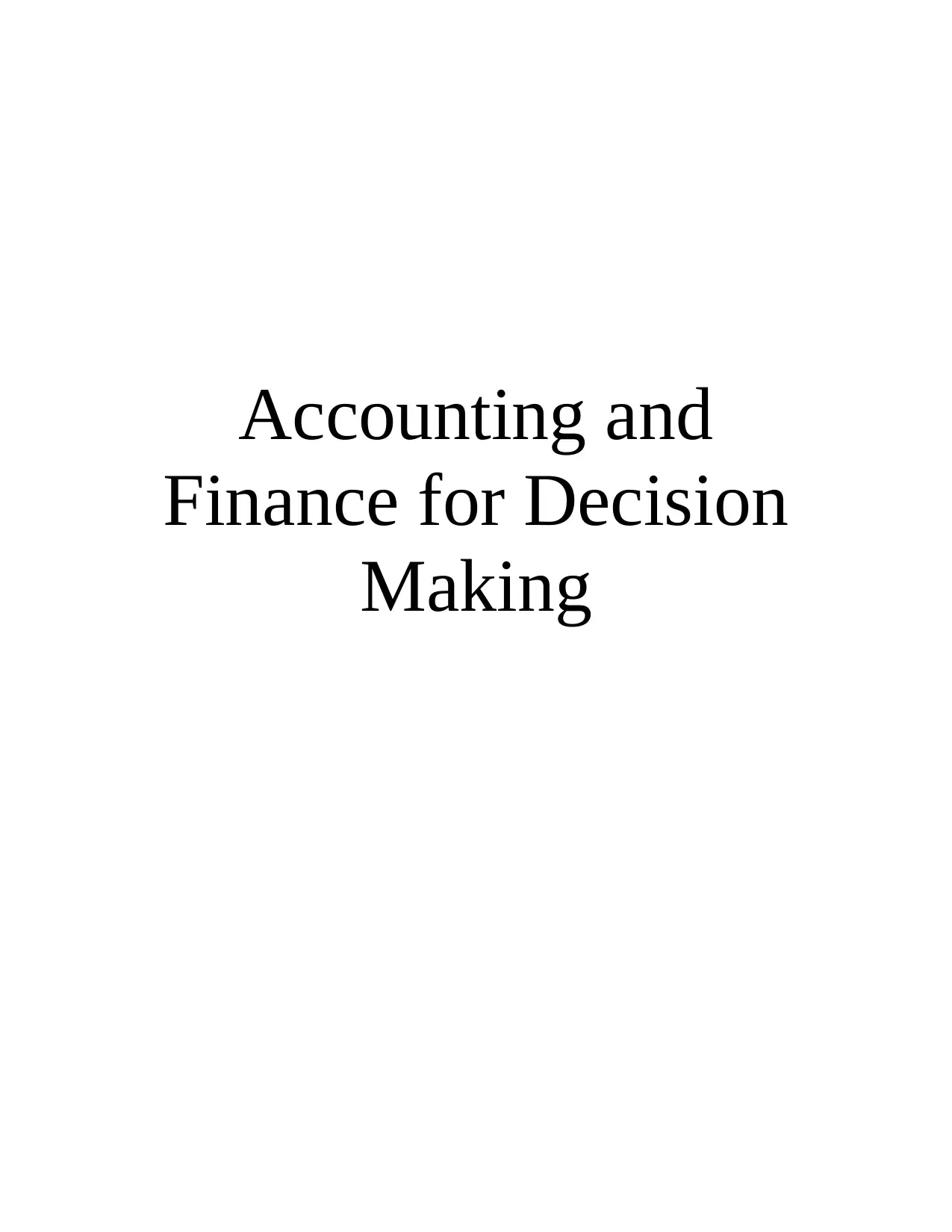
Accounting and
Finance for Decision
Making
Finance for Decision
Making
Paraphrase This Document
Need a fresh take? Get an instant paraphrase of this document with our AI Paraphraser

Contents
1. EXECUTIVE SUMMARY.........................................................................................................3
Motivation of the proposed investment...........................................................................................4
Explain how investment helps in gaining long term growth...........................................................4
Critically deliberate the risk and return and its potential influence on its finance related
performances....................................................................................................................................7
CONCLUSION................................................................................................................................8
REFERENCES................................................................................................................................9
1. EXECUTIVE SUMMARY.........................................................................................................3
Motivation of the proposed investment...........................................................................................4
Explain how investment helps in gaining long term growth...........................................................4
Critically deliberate the risk and return and its potential influence on its finance related
performances....................................................................................................................................7
CONCLUSION................................................................................................................................8
REFERENCES................................................................................................................................9
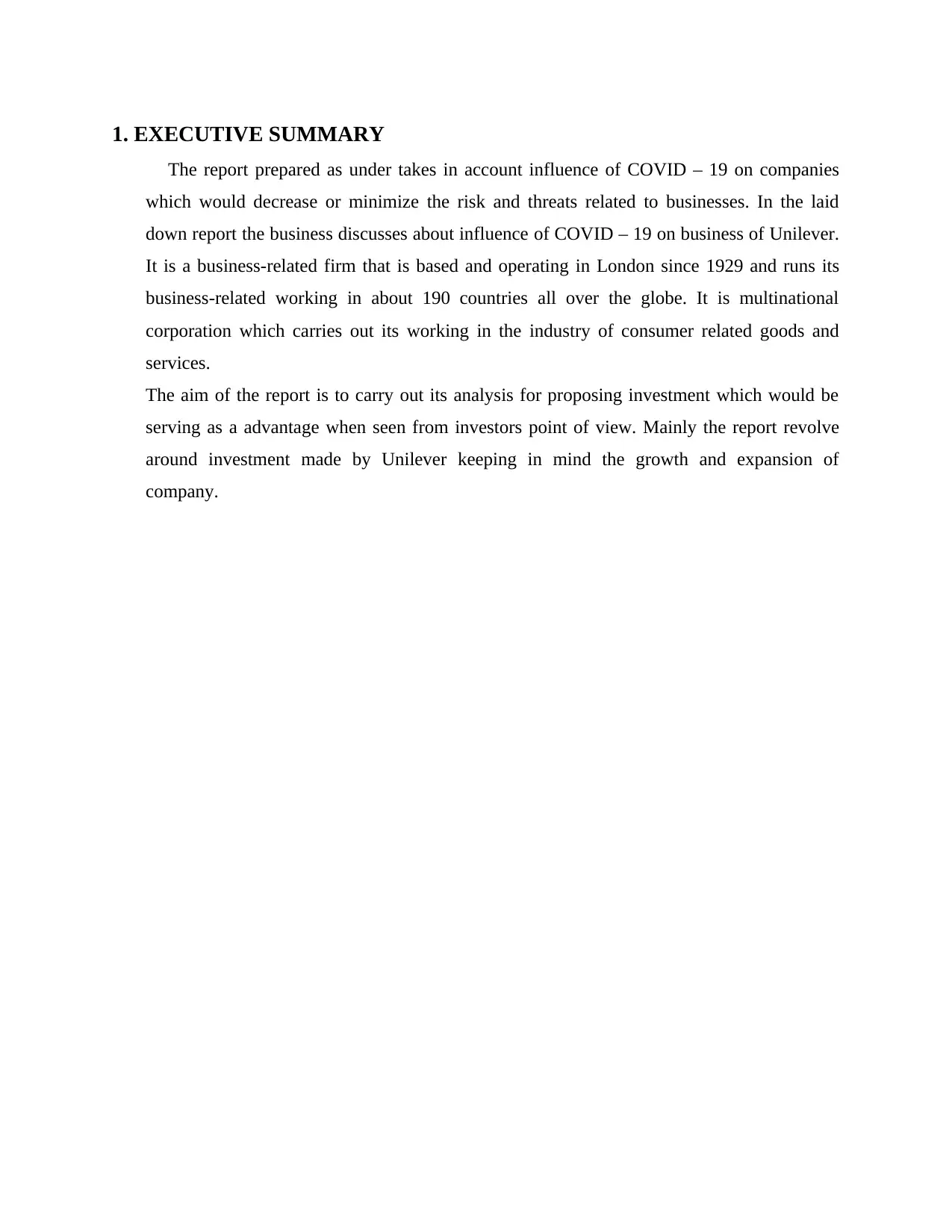
1. EXECUTIVE SUMMARY
The report prepared as under takes in account influence of COVID – 19 on companies
which would decrease or minimize the risk and threats related to businesses. In the laid
down report the business discusses about influence of COVID – 19 on business of Unilever.
It is a business-related firm that is based and operating in London since 1929 and runs its
business-related working in about 190 countries all over the globe. It is multinational
corporation which carries out its working in the industry of consumer related goods and
services.
The aim of the report is to carry out its analysis for proposing investment which would be
serving as a advantage when seen from investors point of view. Mainly the report revolve
around investment made by Unilever keeping in mind the growth and expansion of
company.
The report prepared as under takes in account influence of COVID – 19 on companies
which would decrease or minimize the risk and threats related to businesses. In the laid
down report the business discusses about influence of COVID – 19 on business of Unilever.
It is a business-related firm that is based and operating in London since 1929 and runs its
business-related working in about 190 countries all over the globe. It is multinational
corporation which carries out its working in the industry of consumer related goods and
services.
The aim of the report is to carry out its analysis for proposing investment which would be
serving as a advantage when seen from investors point of view. Mainly the report revolve
around investment made by Unilever keeping in mind the growth and expansion of
company.
⊘ This is a preview!⊘
Do you want full access?
Subscribe today to unlock all pages.

Trusted by 1+ million students worldwide
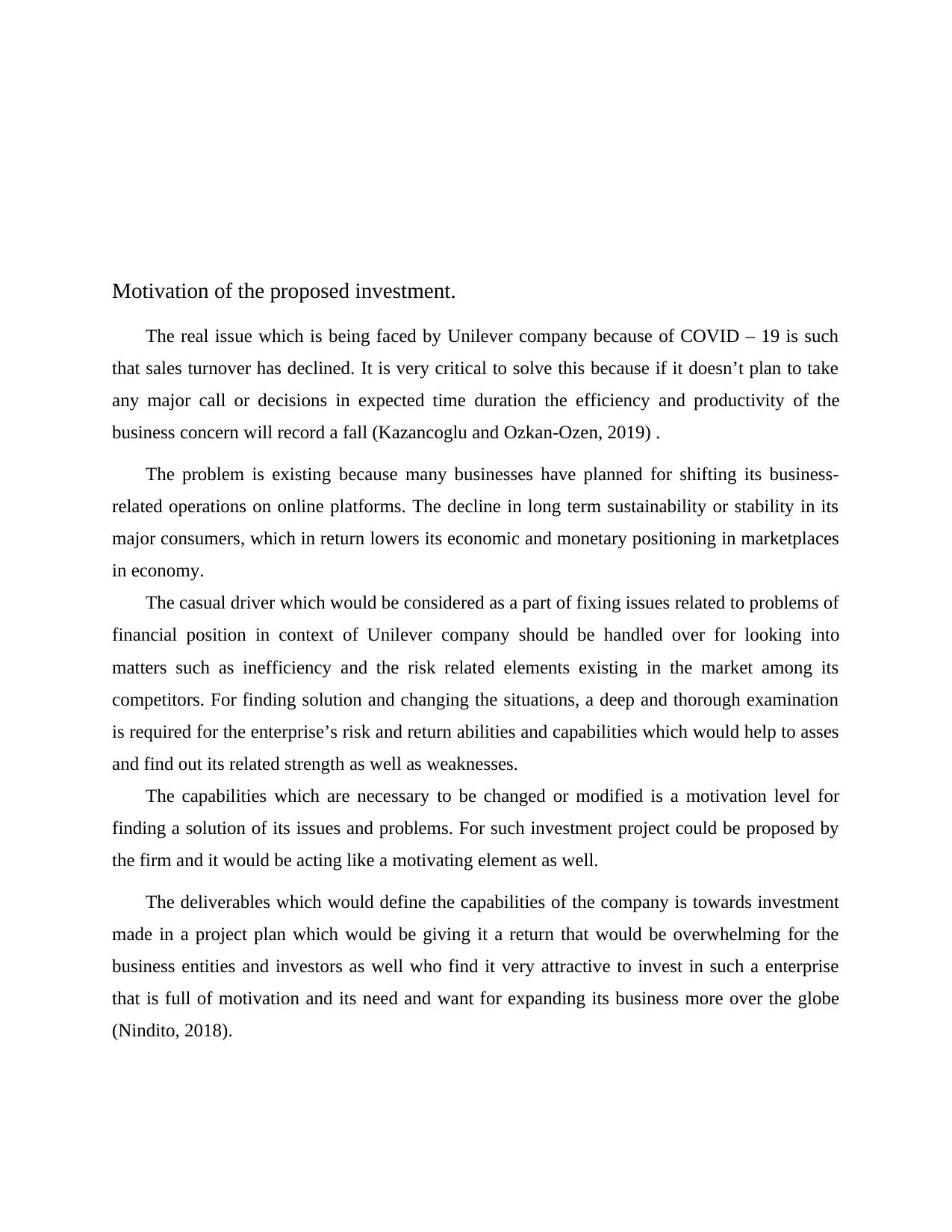
Motivation of the proposed investment.
The real issue which is being faced by Unilever company because of COVID – 19 is such
that sales turnover has declined. It is very critical to solve this because if it doesn’t plan to take
any major call or decisions in expected time duration the efficiency and productivity of the
business concern will record a fall (Kazancoglu and Ozkan-Ozen, 2019) .
The problem is existing because many businesses have planned for shifting its business-
related operations on online platforms. The decline in long term sustainability or stability in its
major consumers, which in return lowers its economic and monetary positioning in marketplaces
in economy.
The casual driver which would be considered as a part of fixing issues related to problems of
financial position in context of Unilever company should be handled over for looking into
matters such as inefficiency and the risk related elements existing in the market among its
competitors. For finding solution and changing the situations, a deep and thorough examination
is required for the enterprise’s risk and return abilities and capabilities which would help to asses
and find out its related strength as well as weaknesses.
The capabilities which are necessary to be changed or modified is a motivation level for
finding a solution of its issues and problems. For such investment project could be proposed by
the firm and it would be acting like a motivating element as well.
The deliverables which would define the capabilities of the company is towards investment
made in a project plan which would be giving it a return that would be overwhelming for the
business entities and investors as well who find it very attractive to invest in such a enterprise
that is full of motivation and its need and want for expanding its business more over the globe
(Nindito, 2018).
The real issue which is being faced by Unilever company because of COVID – 19 is such
that sales turnover has declined. It is very critical to solve this because if it doesn’t plan to take
any major call or decisions in expected time duration the efficiency and productivity of the
business concern will record a fall (Kazancoglu and Ozkan-Ozen, 2019) .
The problem is existing because many businesses have planned for shifting its business-
related operations on online platforms. The decline in long term sustainability or stability in its
major consumers, which in return lowers its economic and monetary positioning in marketplaces
in economy.
The casual driver which would be considered as a part of fixing issues related to problems of
financial position in context of Unilever company should be handled over for looking into
matters such as inefficiency and the risk related elements existing in the market among its
competitors. For finding solution and changing the situations, a deep and thorough examination
is required for the enterprise’s risk and return abilities and capabilities which would help to asses
and find out its related strength as well as weaknesses.
The capabilities which are necessary to be changed or modified is a motivation level for
finding a solution of its issues and problems. For such investment project could be proposed by
the firm and it would be acting like a motivating element as well.
The deliverables which would define the capabilities of the company is towards investment
made in a project plan which would be giving it a return that would be overwhelming for the
business entities and investors as well who find it very attractive to invest in such a enterprise
that is full of motivation and its need and want for expanding its business more over the globe
(Nindito, 2018).
Paraphrase This Document
Need a fresh take? Get an instant paraphrase of this document with our AI Paraphraser
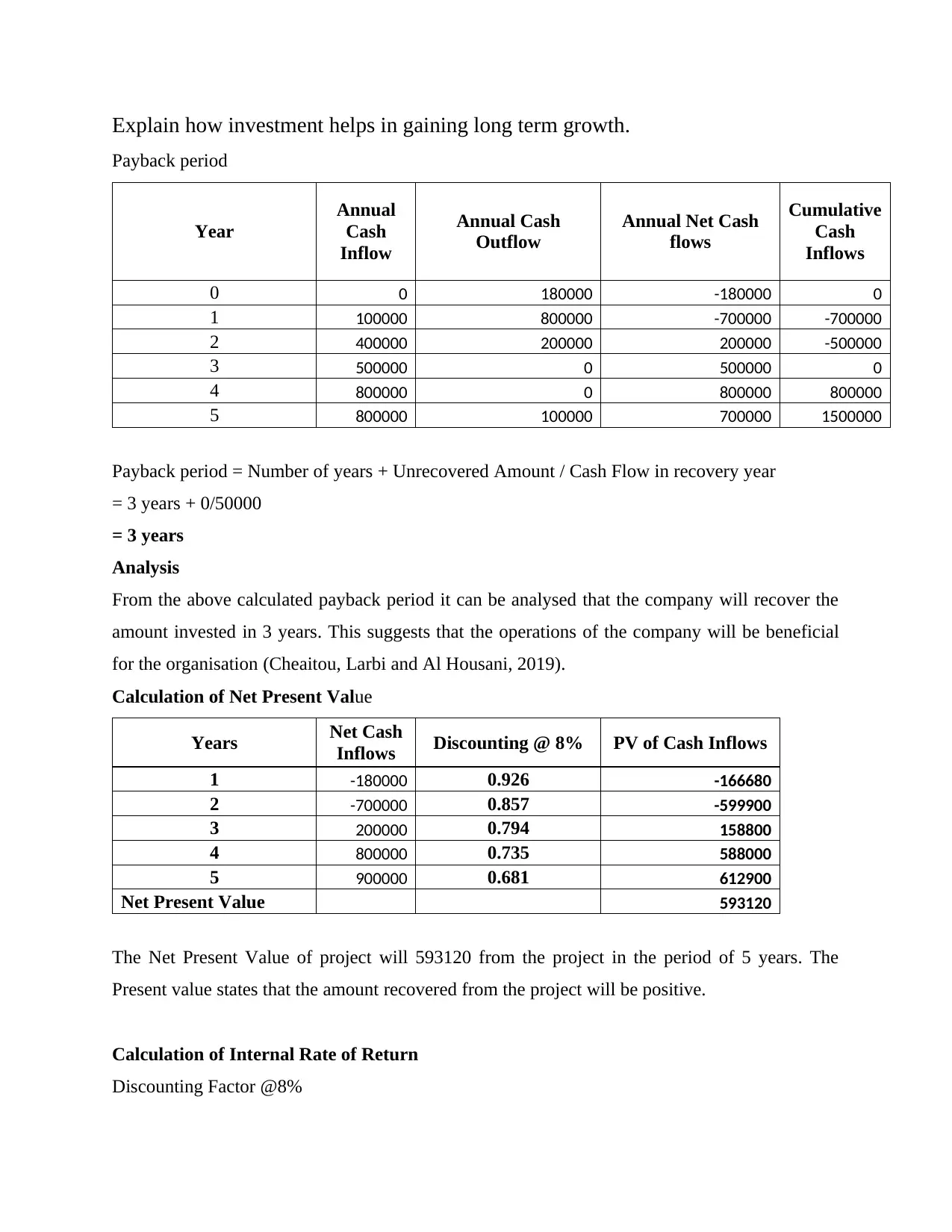
Explain how investment helps in gaining long term growth.
Payback period
Year
Annual
Cash
Inflow
Annual Cash
Outflow
Annual Net Cash
flows
Cumulative
Cash
Inflows
0 0 180000 -180000 0
1 100000 800000 -700000 -700000
2 400000 200000 200000 -500000
3 500000 0 500000 0
4 800000 0 800000 800000
5 800000 100000 700000 1500000
Payback period = Number of years + Unrecovered Amount / Cash Flow in recovery year
= 3 years + 0/50000
= 3 years
Analysis
From the above calculated payback period it can be analysed that the company will recover the
amount invested in 3 years. This suggests that the operations of the company will be beneficial
for the organisation (Cheaitou, Larbi and Al Housani, 2019).
Calculation of Net Present Value
Years Net Cash
Inflows Discounting @ 8% PV of Cash Inflows
1 -180000 0.926 -166680
2 -700000 0.857 -599900
3 200000 0.794 158800
4 800000 0.735 588000
5 900000 0.681 612900
Net Present Value 593120
The Net Present Value of project will 593120 from the project in the period of 5 years. The
Present value states that the amount recovered from the project will be positive.
Calculation of Internal Rate of Return
Discounting Factor @8%
Payback period
Year
Annual
Cash
Inflow
Annual Cash
Outflow
Annual Net Cash
flows
Cumulative
Cash
Inflows
0 0 180000 -180000 0
1 100000 800000 -700000 -700000
2 400000 200000 200000 -500000
3 500000 0 500000 0
4 800000 0 800000 800000
5 800000 100000 700000 1500000
Payback period = Number of years + Unrecovered Amount / Cash Flow in recovery year
= 3 years + 0/50000
= 3 years
Analysis
From the above calculated payback period it can be analysed that the company will recover the
amount invested in 3 years. This suggests that the operations of the company will be beneficial
for the organisation (Cheaitou, Larbi and Al Housani, 2019).
Calculation of Net Present Value
Years Net Cash
Inflows Discounting @ 8% PV of Cash Inflows
1 -180000 0.926 -166680
2 -700000 0.857 -599900
3 200000 0.794 158800
4 800000 0.735 588000
5 900000 0.681 612900
Net Present Value 593120
The Net Present Value of project will 593120 from the project in the period of 5 years. The
Present value states that the amount recovered from the project will be positive.
Calculation of Internal Rate of Return
Discounting Factor @8%
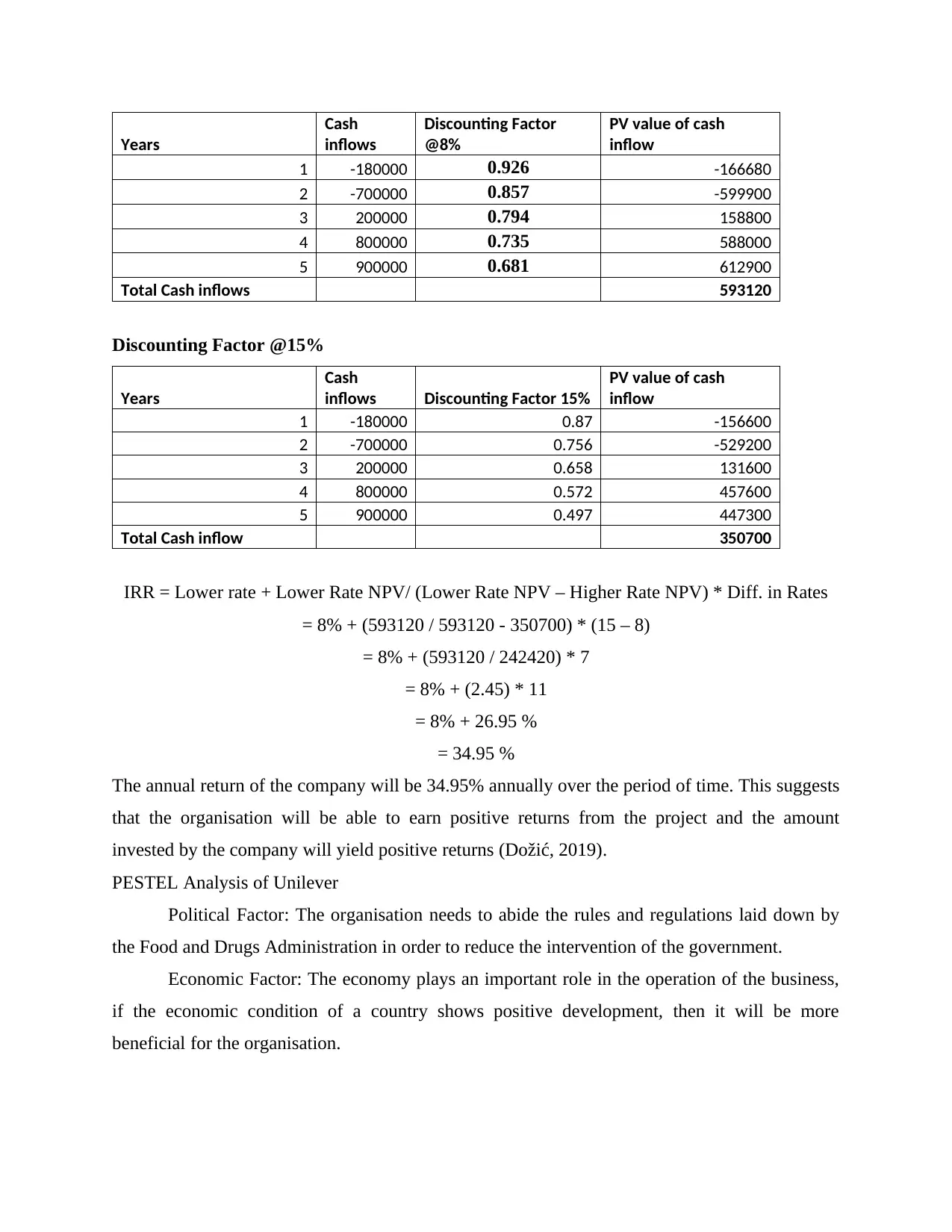
Years
Cash
inflows
Discounting Factor
@8%
PV value of cash
inflow
1 -180000 0.926 -166680
2 -700000 0.857 -599900
3 200000 0.794 158800
4 800000 0.735 588000
5 900000 0.681 612900
Total Cash inflows 593120
Discounting Factor @15%
Years
Cash
inflows Discounting Factor 15%
PV value of cash
inflow
1 -180000 0.87 -156600
2 -700000 0.756 -529200
3 200000 0.658 131600
4 800000 0.572 457600
5 900000 0.497 447300
Total Cash inflow 350700
IRR = Lower rate + Lower Rate NPV/ (Lower Rate NPV – Higher Rate NPV) * Diff. in Rates
= 8% + (593120 / 593120 - 350700) * (15 – 8)
= 8% + (593120 / 242420) * 7
= 8% + (2.45) * 11
= 8% + 26.95 %
= 34.95 %
The annual return of the company will be 34.95% annually over the period of time. This suggests
that the organisation will be able to earn positive returns from the project and the amount
invested by the company will yield positive returns (Dožić, 2019).
PESTEL Analysis of Unilever
Political Factor: The organisation needs to abide the rules and regulations laid down by
the Food and Drugs Administration in order to reduce the intervention of the government.
Economic Factor: The economy plays an important role in the operation of the business,
if the economic condition of a country shows positive development, then it will be more
beneficial for the organisation.
Cash
inflows
Discounting Factor
@8%
PV value of cash
inflow
1 -180000 0.926 -166680
2 -700000 0.857 -599900
3 200000 0.794 158800
4 800000 0.735 588000
5 900000 0.681 612900
Total Cash inflows 593120
Discounting Factor @15%
Years
Cash
inflows Discounting Factor 15%
PV value of cash
inflow
1 -180000 0.87 -156600
2 -700000 0.756 -529200
3 200000 0.658 131600
4 800000 0.572 457600
5 900000 0.497 447300
Total Cash inflow 350700
IRR = Lower rate + Lower Rate NPV/ (Lower Rate NPV – Higher Rate NPV) * Diff. in Rates
= 8% + (593120 / 593120 - 350700) * (15 – 8)
= 8% + (593120 / 242420) * 7
= 8% + (2.45) * 11
= 8% + 26.95 %
= 34.95 %
The annual return of the company will be 34.95% annually over the period of time. This suggests
that the organisation will be able to earn positive returns from the project and the amount
invested by the company will yield positive returns (Dožić, 2019).
PESTEL Analysis of Unilever
Political Factor: The organisation needs to abide the rules and regulations laid down by
the Food and Drugs Administration in order to reduce the intervention of the government.
Economic Factor: The economy plays an important role in the operation of the business,
if the economic condition of a country shows positive development, then it will be more
beneficial for the organisation.
⊘ This is a preview!⊘
Do you want full access?
Subscribe today to unlock all pages.

Trusted by 1+ million students worldwide
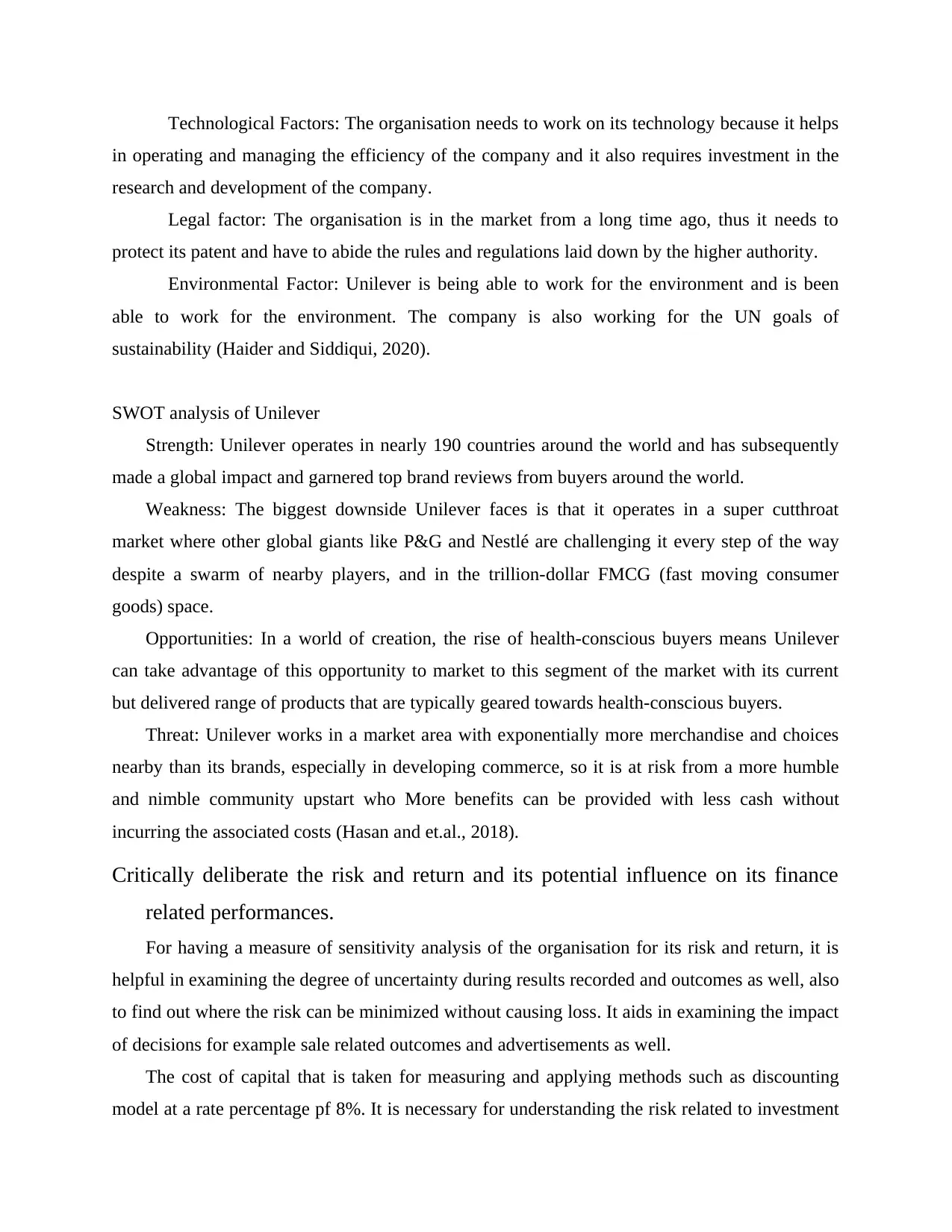
Technological Factors: The organisation needs to work on its technology because it helps
in operating and managing the efficiency of the company and it also requires investment in the
research and development of the company.
Legal factor: The organisation is in the market from a long time ago, thus it needs to
protect its patent and have to abide the rules and regulations laid down by the higher authority.
Environmental Factor: Unilever is being able to work for the environment and is been
able to work for the environment. The company is also working for the UN goals of
sustainability (Haider and Siddiqui, 2020).
SWOT analysis of Unilever
Strength: Unilever operates in nearly 190 countries around the world and has subsequently
made a global impact and garnered top brand reviews from buyers around the world.
Weakness: The biggest downside Unilever faces is that it operates in a super cutthroat
market where other global giants like P&G and Nestlé are challenging it every step of the way
despite a swarm of nearby players, and in the trillion-dollar FMCG (fast moving consumer
goods) space.
Opportunities: In a world of creation, the rise of health-conscious buyers means Unilever
can take advantage of this opportunity to market to this segment of the market with its current
but delivered range of products that are typically geared towards health-conscious buyers.
Threat: Unilever works in a market area with exponentially more merchandise and choices
nearby than its brands, especially in developing commerce, so it is at risk from a more humble
and nimble community upstart who More benefits can be provided with less cash without
incurring the associated costs (Hasan and et.al., 2018).
Critically deliberate the risk and return and its potential influence on its finance
related performances.
For having a measure of sensitivity analysis of the organisation for its risk and return, it is
helpful in examining the degree of uncertainty during results recorded and outcomes as well, also
to find out where the risk can be minimized without causing loss. It aids in examining the impact
of decisions for example sale related outcomes and advertisements as well.
The cost of capital that is taken for measuring and applying methods such as discounting
model at a rate percentage pf 8%. It is necessary for understanding the risk related to investment
in operating and managing the efficiency of the company and it also requires investment in the
research and development of the company.
Legal factor: The organisation is in the market from a long time ago, thus it needs to
protect its patent and have to abide the rules and regulations laid down by the higher authority.
Environmental Factor: Unilever is being able to work for the environment and is been
able to work for the environment. The company is also working for the UN goals of
sustainability (Haider and Siddiqui, 2020).
SWOT analysis of Unilever
Strength: Unilever operates in nearly 190 countries around the world and has subsequently
made a global impact and garnered top brand reviews from buyers around the world.
Weakness: The biggest downside Unilever faces is that it operates in a super cutthroat
market where other global giants like P&G and Nestlé are challenging it every step of the way
despite a swarm of nearby players, and in the trillion-dollar FMCG (fast moving consumer
goods) space.
Opportunities: In a world of creation, the rise of health-conscious buyers means Unilever
can take advantage of this opportunity to market to this segment of the market with its current
but delivered range of products that are typically geared towards health-conscious buyers.
Threat: Unilever works in a market area with exponentially more merchandise and choices
nearby than its brands, especially in developing commerce, so it is at risk from a more humble
and nimble community upstart who More benefits can be provided with less cash without
incurring the associated costs (Hasan and et.al., 2018).
Critically deliberate the risk and return and its potential influence on its finance
related performances.
For having a measure of sensitivity analysis of the organisation for its risk and return, it is
helpful in examining the degree of uncertainty during results recorded and outcomes as well, also
to find out where the risk can be minimized without causing loss. It aids in examining the impact
of decisions for example sale related outcomes and advertisements as well.
The cost of capital that is taken for measuring and applying methods such as discounting
model at a rate percentage pf 8%. It is necessary for understanding the risk related to investment
Paraphrase This Document
Need a fresh take? Get an instant paraphrase of this document with our AI Paraphraser
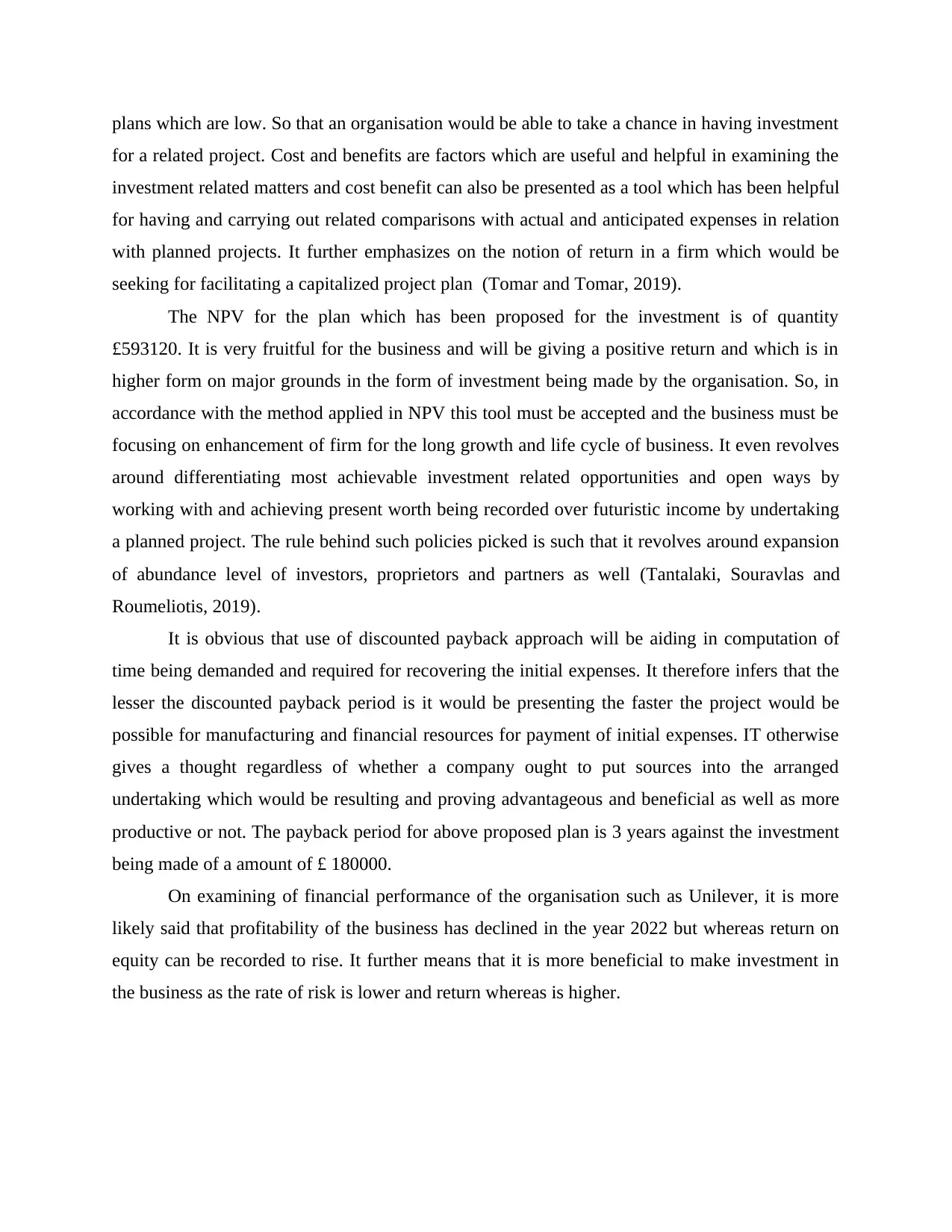
plans which are low. So that an organisation would be able to take a chance in having investment
for a related project. Cost and benefits are factors which are useful and helpful in examining the
investment related matters and cost benefit can also be presented as a tool which has been helpful
for having and carrying out related comparisons with actual and anticipated expenses in relation
with planned projects. It further emphasizes on the notion of return in a firm which would be
seeking for facilitating a capitalized project plan (Tomar and Tomar, 2019).
The NPV for the plan which has been proposed for the investment is of quantity
£593120. It is very fruitful for the business and will be giving a positive return and which is in
higher form on major grounds in the form of investment being made by the organisation. So, in
accordance with the method applied in NPV this tool must be accepted and the business must be
focusing on enhancement of firm for the long growth and life cycle of business. It even revolves
around differentiating most achievable investment related opportunities and open ways by
working with and achieving present worth being recorded over futuristic income by undertaking
a planned project. The rule behind such policies picked is such that it revolves around expansion
of abundance level of investors, proprietors and partners as well (Tantalaki, Souravlas and
Roumeliotis, 2019).
It is obvious that use of discounted payback approach will be aiding in computation of
time being demanded and required for recovering the initial expenses. It therefore infers that the
lesser the discounted payback period is it would be presenting the faster the project would be
possible for manufacturing and financial resources for payment of initial expenses. IT otherwise
gives a thought regardless of whether a company ought to put sources into the arranged
undertaking which would be resulting and proving advantageous and beneficial as well as more
productive or not. The payback period for above proposed plan is 3 years against the investment
being made of a amount of £ 180000.
On examining of financial performance of the organisation such as Unilever, it is more
likely said that profitability of the business has declined in the year 2022 but whereas return on
equity can be recorded to rise. It further means that it is more beneficial to make investment in
the business as the rate of risk is lower and return whereas is higher.
for a related project. Cost and benefits are factors which are useful and helpful in examining the
investment related matters and cost benefit can also be presented as a tool which has been helpful
for having and carrying out related comparisons with actual and anticipated expenses in relation
with planned projects. It further emphasizes on the notion of return in a firm which would be
seeking for facilitating a capitalized project plan (Tomar and Tomar, 2019).
The NPV for the plan which has been proposed for the investment is of quantity
£593120. It is very fruitful for the business and will be giving a positive return and which is in
higher form on major grounds in the form of investment being made by the organisation. So, in
accordance with the method applied in NPV this tool must be accepted and the business must be
focusing on enhancement of firm for the long growth and life cycle of business. It even revolves
around differentiating most achievable investment related opportunities and open ways by
working with and achieving present worth being recorded over futuristic income by undertaking
a planned project. The rule behind such policies picked is such that it revolves around expansion
of abundance level of investors, proprietors and partners as well (Tantalaki, Souravlas and
Roumeliotis, 2019).
It is obvious that use of discounted payback approach will be aiding in computation of
time being demanded and required for recovering the initial expenses. It therefore infers that the
lesser the discounted payback period is it would be presenting the faster the project would be
possible for manufacturing and financial resources for payment of initial expenses. IT otherwise
gives a thought regardless of whether a company ought to put sources into the arranged
undertaking which would be resulting and proving advantageous and beneficial as well as more
productive or not. The payback period for above proposed plan is 3 years against the investment
being made of a amount of £ 180000.
On examining of financial performance of the organisation such as Unilever, it is more
likely said that profitability of the business has declined in the year 2022 but whereas return on
equity can be recorded to rise. It further means that it is more beneficial to make investment in
the business as the rate of risk is lower and return whereas is higher.
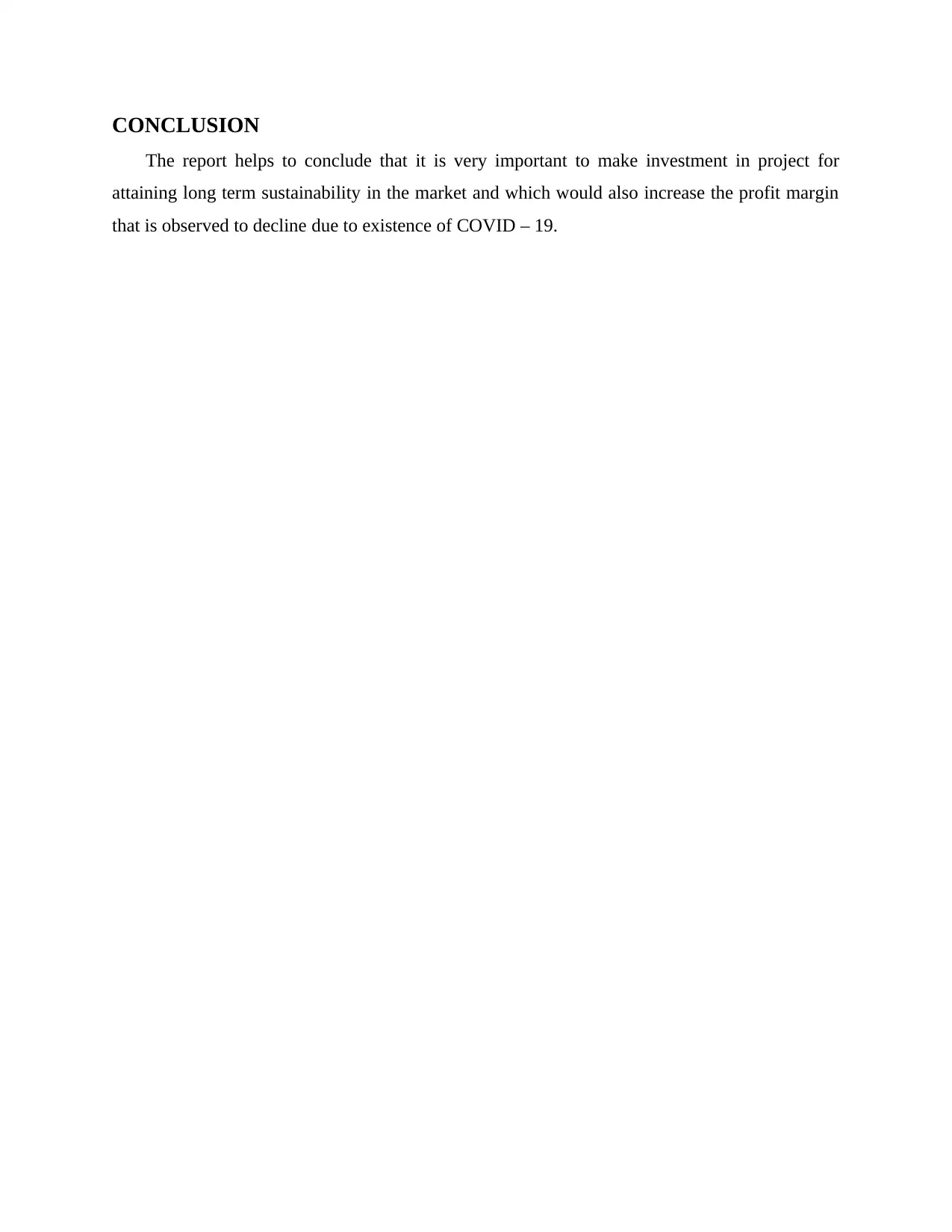
CONCLUSION
The report helps to conclude that it is very important to make investment in project for
attaining long term sustainability in the market and which would also increase the profit margin
that is observed to decline due to existence of COVID – 19.
The report helps to conclude that it is very important to make investment in project for
attaining long term sustainability in the market and which would also increase the profit margin
that is observed to decline due to existence of COVID – 19.
⊘ This is a preview!⊘
Do you want full access?
Subscribe today to unlock all pages.

Trusted by 1+ million students worldwide
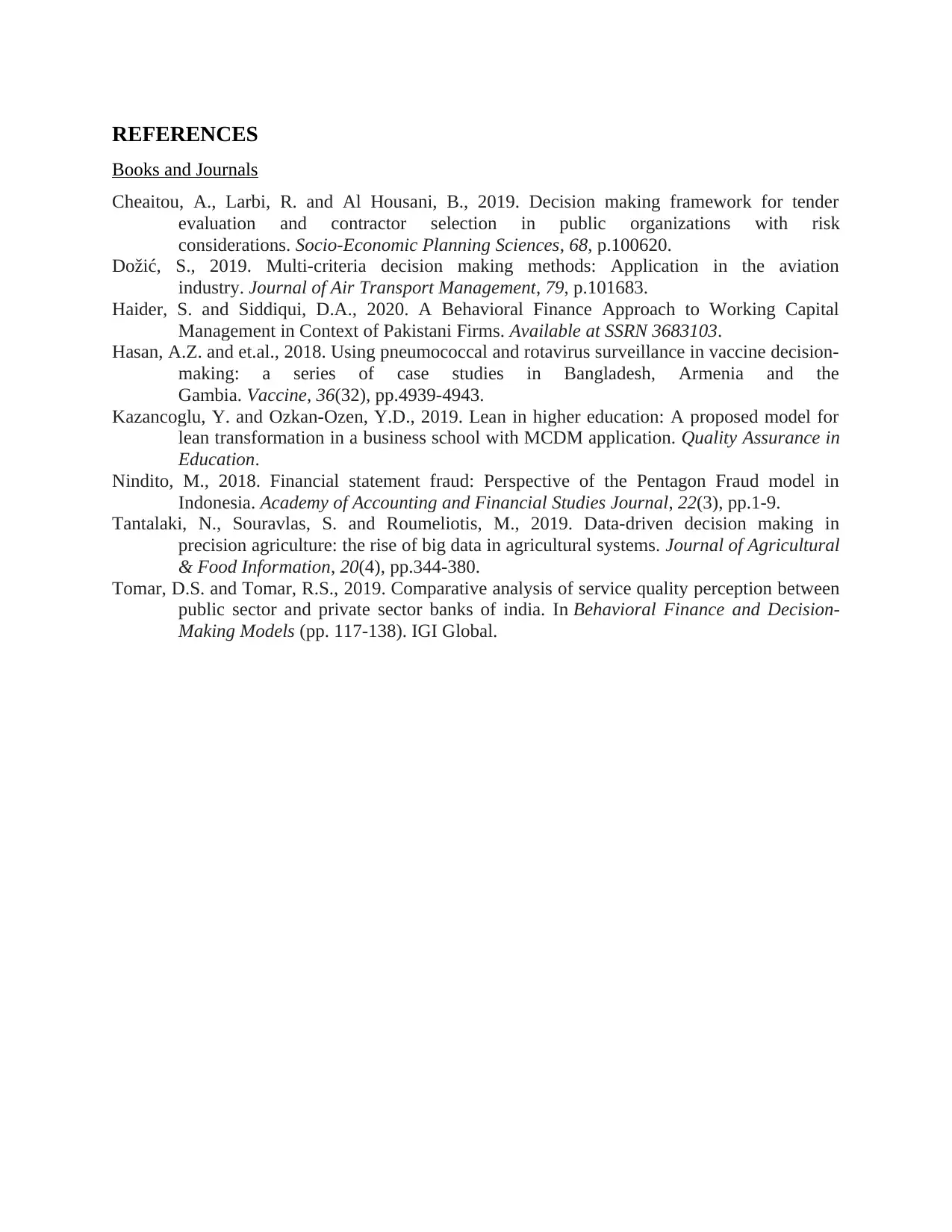
REFERENCES
Books and Journals
Cheaitou, A., Larbi, R. and Al Housani, B., 2019. Decision making framework for tender
evaluation and contractor selection in public organizations with risk
considerations. Socio-Economic Planning Sciences, 68, p.100620.
Dožić, S., 2019. Multi-criteria decision making methods: Application in the aviation
industry. Journal of Air Transport Management, 79, p.101683.
Haider, S. and Siddiqui, D.A., 2020. A Behavioral Finance Approach to Working Capital
Management in Context of Pakistani Firms. Available at SSRN 3683103.
Hasan, A.Z. and et.al., 2018. Using pneumococcal and rotavirus surveillance in vaccine decision-
making: a series of case studies in Bangladesh, Armenia and the
Gambia. Vaccine, 36(32), pp.4939-4943.
Kazancoglu, Y. and Ozkan-Ozen, Y.D., 2019. Lean in higher education: A proposed model for
lean transformation in a business school with MCDM application. Quality Assurance in
Education.
Nindito, M., 2018. Financial statement fraud: Perspective of the Pentagon Fraud model in
Indonesia. Academy of Accounting and Financial Studies Journal, 22(3), pp.1-9.
Tantalaki, N., Souravlas, S. and Roumeliotis, M., 2019. Data-driven decision making in
precision agriculture: the rise of big data in agricultural systems. Journal of Agricultural
& Food Information, 20(4), pp.344-380.
Tomar, D.S. and Tomar, R.S., 2019. Comparative analysis of service quality perception between
public sector and private sector banks of india. In Behavioral Finance and Decision-
Making Models (pp. 117-138). IGI Global.
Books and Journals
Cheaitou, A., Larbi, R. and Al Housani, B., 2019. Decision making framework for tender
evaluation and contractor selection in public organizations with risk
considerations. Socio-Economic Planning Sciences, 68, p.100620.
Dožić, S., 2019. Multi-criteria decision making methods: Application in the aviation
industry. Journal of Air Transport Management, 79, p.101683.
Haider, S. and Siddiqui, D.A., 2020. A Behavioral Finance Approach to Working Capital
Management in Context of Pakistani Firms. Available at SSRN 3683103.
Hasan, A.Z. and et.al., 2018. Using pneumococcal and rotavirus surveillance in vaccine decision-
making: a series of case studies in Bangladesh, Armenia and the
Gambia. Vaccine, 36(32), pp.4939-4943.
Kazancoglu, Y. and Ozkan-Ozen, Y.D., 2019. Lean in higher education: A proposed model for
lean transformation in a business school with MCDM application. Quality Assurance in
Education.
Nindito, M., 2018. Financial statement fraud: Perspective of the Pentagon Fraud model in
Indonesia. Academy of Accounting and Financial Studies Journal, 22(3), pp.1-9.
Tantalaki, N., Souravlas, S. and Roumeliotis, M., 2019. Data-driven decision making in
precision agriculture: the rise of big data in agricultural systems. Journal of Agricultural
& Food Information, 20(4), pp.344-380.
Tomar, D.S. and Tomar, R.S., 2019. Comparative analysis of service quality perception between
public sector and private sector banks of india. In Behavioral Finance and Decision-
Making Models (pp. 117-138). IGI Global.
1 out of 10
Related Documents
Your All-in-One AI-Powered Toolkit for Academic Success.
+13062052269
info@desklib.com
Available 24*7 on WhatsApp / Email
![[object Object]](/_next/static/media/star-bottom.7253800d.svg)
Unlock your academic potential
© 2024 | Zucol Services PVT LTD | All rights reserved.



